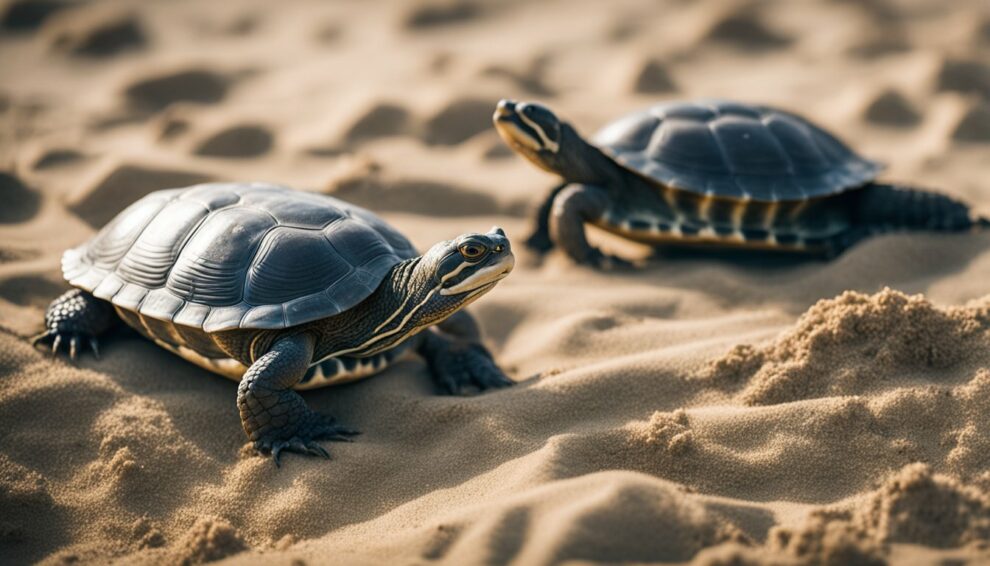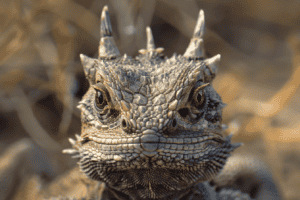Softshell turtles have a peculiar and impressive ability to bury themselves in sand.
Imagine you’re at the riverside, and you spot a turtle with a pancake-shaped shell; you’re looking at a softshell turtle.
Unlike their hard-shelled cousins, these turtles have a leathery carapace that allows them flexibility and a surprising turn of speed both in water and on land.
When it comes to safety and egg-laying, these turtles use their powerful limbs to perform a rapid sand burial, disappearing before your eyes like magicians of the riverbank.

Now, you might wonder why these turtles have to bury themselves so quickly. It turns out, speed is key in the wild.
Softshell turtles aren’t just showing off; they’re dodging predators and creating safe nests for their future offspring.
Have you ever built a sandcastle?
If so, you know working with sand can be tricky, but softshell turtles are nature’s experts at manipulating this grainy material.
They can dig into the sand and pull it over themselves in a flash, which is pretty cool if you think about how important that skill is for their survival.
But how do they do this so fast? A combination of their webbed feet and pointed snout works wonders.
These turtles use their unique physical features to shovel and push the sand, making quick work of what seems like a tedious task.
This rapid burial isn’t just for hiding; it’s also about temperature regulation and moisture retention, essential aspects of their biology.
So, the next time you see sand suddenly moving by the water, look closely — you might just catch a glimpse of a softshell turtle at work.
Unveiling the Softshell Turtle

Softshell turtles are remarkable for their unique adaptations and behaviors.
One of their most surprising abilities is how quickly they can bury themselves in the sand.
Let’s take a closer look at what makes them stand out and where they prefer to live.
Distinctive Traits
Softshell turtles distinguish themselves by their flattened, leathery shells, which are quite different from the hard casings most turtles have.
Unlike their hard-shelled cousins, these turtles have a more hydrodynamic build, which helps them glide swiftly through the water.
They have long, snorkel-like noses, allowing them to breathe while submerged, with only a tiny part of their body exposed.
When threatened, they can dart away at speeds that surprise even experienced naturalists, and if they need to hide, they can vanish into the sand in moments.
Scientists have measured their reaction times and found they can completely bury themselves in sand in less than two seconds!
Habitat Preferences
The softshell turtle makes its home in freshwater environments ranging from slow-moving rivers and streams to larger lakes and ponds.
These environments provide ample opportunity for the turtles to utilize their sand-burial strategy, whether for escaping predators or for capturing unwary prey.
They are often found in habitats with soft, muddy, or sandy bottoms, which are essential for their unique burrowing behavior.
Consistent water conditions are important, too, as rapid changes can stress the turtles and affect their ability to find food and reproduce.
Spotting a softshell turtle can be quite a challenge, as they blend in so well with their surroundings that even keen eyes might miss them at first glance.
Have you ever seen an odd ripple on the water and wondered what caused it?
It might have been a softshell turtle, just beneath the surface, waiting for the perfect moment to emerge or disappear back into its sandy hideaway.
The Sand Burial Technique

Softshell turtles have an incredible behavior of burying themselves in the sand—a technique used for both survival and daily activities.
The Purpose of Sand Burial
The act of burying beneath the sand serves multiple purposes for softshell turtles.
They use sand burial to evade predators, create a comfortable habitat, regulate body temperature, and for females, to nest and protect their eggs.
Sneaking beneath the sand also allows them to launch surprise attacks on prey.
The sand acts as a natural camouflage, rendering the turtles almost invisible to both predators and prey.
How Turtles Execute the Sand Burial
When a softshell turtle decides it’s time to disappear into the sandy bottom of its watery home, it starts by using its powerful limbs.
This limb action is a bit like an efficient shovel, swiftly displacing the surrounding sand.
They position their streamlined, flat bodies to easily slip under the surface.
With rapid and precise movements, they toss sand over their back and wiggle to aid the sediment in settling over their shell.
Within minutes, they can become entirely hidden from sight, with only their eyes and snouts peeking out if necessary, for them to breathe and watch the world go by without being detected.
Speed Analysis

When one thinks of turtles, speed isn’t typically the first trait that comes to mind.
Yet, softshell turtles have an extraordinary ability to burrow into sand swiftly.
This section delves into the pace at which these turtles disappear beneath the sands and the various elements that play a part in this quick process.
Comparing Speeds
Softshell turtles are known for their lightning-fast burrowing abilities in contrast to their slow-moving reputation.
Observational data indicates that some softshell species can burrow into the sand in under two minutes.
The average human, tasked with a similar challenge without tools, would be hard-pressed to match this speed.
It’s not just about velocity but also the turtle’s technique.
They use their spade-like limbs with a proficiency that’s both effective and efficient.
Factors Influencing Burial Speed
A myriad of factors contributes to the burial speed of softshell turtles.
The type of sand—whether it’s coarse or fine—greatly affects how quickly a turtle can burrow.
Coarser sand tends to provide more resistance, which might slow the turtle down slightly.
Yet, their strong limbs are well-equipped for the challenge, allowing them to scoop and push their way through with surprising agility.
Soil moisture also plays a role.
Sand that’s slightly damp is often easier for turtles to move, as it clumps together, allowing for quicker displacement.
Temperature can influence their speed as well; softshell turtles tend to be more active in warmer conditions, giving them the vivacity needed for rapid burials.
The turtle’s size and age may also be critical, with larger and more mature turtles employing their greater experience and strength to bury themselves more speedily than their younger counterparts.
Have you ever wondered how these creatures manage such a task with apparent ease?
It’s their life, a survival skill honed to perfection that allows them to evade predators and thrive in their sandy habitats.
This quicksand vanishing act is just one of the many wonders of the natural world.
Frequently Asked Questions
Understanding the unique behavior of softshell turtles in their sandy habitats opens a fascinating world of reptilian habits.
From their surprising speed in sand burial to the ways they adapt to their environments, these intriguing aspects are bound to pique your curiosity.
How quickly can softshell turtles bury themselves in the sand?
Softshell turtles are impressively swift when it comes to burying themselves, managing to do so in just a few minutes.
This rapid disappearance act is crucial for their survival, allowing them to evade predators and regulate their body temperature.
What factors affect the burial speed of a softshell turtle?
A softshell turtle’s speed in sinking into the sand can be influenced by the type of sand, its moisture content, and the turtle’s size and health.
Dry, fine sand allows for quicker burrowing, whereas wet or coarse sand may slow them down.
Is it common for Florida softshell turtles to dig into sandy terrain?
Yes, Florida softshell turtles are often seen indulging in this behavior.
They’re well-adapted to life in sandy environments and frequently use sand to hide from threats or as a way to ambush prey.
How does the burrowing behavior benefit softshell turtles in the wild?
Burrowing is a critical survival strategy for softshell turtles.
It provides them with a means of escaping predators, creates a cool refuge from the sun, and serves as a stealthy spot for catching a meal.
In essence, it’s their own personal camouflage and fortress.
Can softshell turtles still bury themselves efficiently in captive environments?
In captivity, softshell turtles can maintain their burrowing abilities, provided they have a habitat with suitable sand.
A carefully designed environment will support this natural behavior, which is essential for both their physical and psychological well-being.
What should be considered when providing a sandy habitat for a pet softshell turtle?
When setting up a sand area for a pet softshell turtle, take into account the grain size, depth, and cleanliness of the sand.
Ensure it’s free of sharp edges and contaminants.
The sand should also be deep enough to allow the turtle to bury itself completely, replicating their natural conditions.









